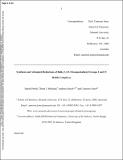Synthesis and attempted reductions of bulky 1,3,5-triazapentadienyl groups 2 and 13 halide complexes
Abstract
Three extremely bulky 1,3,5-triazapentadienes, ArNNNH (ArNNN = N{C(But)=N(Ar)}2; Ar = Mes (mesityl), Dep (2,6-diethylphenyl) or Dip (2,6-diisopropylphenyl)) have been prepared and structurally characterized. These are readily deprotonated, yielding a series of lithium and potassium triazapentadienyl complexes, one of which, (DipNNN)Li, has been structurally characterized. Similarly, three monomeric triazapentadienyl magnesium iodide complexes, (ArNNN)MgI(OEt2), and a dimeric calcium counterpart, {(MesNNN)Ca(THF)(μ-I)}2, have been prepared. Attempts to reduce the former gave homoleptic bis(triazapentadienyl) magnesium complexes, (ArNNN)2Mg (Ar = Mes or Dep) as the main products. One reaction also gave a very low yield of the magnesium(I) dimer, {(DepNNN)Mg−}2, which was structurally characterized. In related chemistry, two triazapentadienyl boron difluoride compounds, (ArNNN)BF2 (Ar = Mes or Dep), have been synthesized, and unsuccessful attempts made to reduce these to boron(I) heterocycles. For sake of comparison, attempts have been made to prepare a series of related amino-substituted β-diketiminato group 13 element(I) heterocycles. While these were also not successful, several group 13 element(III) halide complexes incorporating this ligand class, and related amino-substituted β-diketiminates, have been characterized.
Citation
Pernik , I , Maitland , B , Stasch , A & Jones , C 2018 , ' Synthesis and attempted reductions of bulky 1,3,5-triazapentadienyl groups 2 and 13 halide complexes ' , Canadian Journal of Chemistry , vol. 96 , no. 6 , cjc-2017-0548 , pp. 513-521 . https://doi.org/10.1139/cjc-2017-0548
Publication
Canadian Journal of Chemistry
Status
Peer reviewed
ISSN
0008-4042Type
Journal article
Description
This research was supported by the Australian Research Council and the US Air Force Asian Office of Aerospace Research and Development (grant FA23861141114043 to CJ).Collections
Items in the St Andrews Research Repository are protected by copyright, with all rights reserved, unless otherwise indicated.

